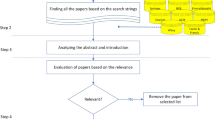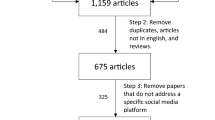Abstract
The local family relationship discovery problem in location-based social network (LBSN) services is to identify whether two local residents in a city belong to the same family or not by using their check-in traces on LBSNs. This information is critical for many applications, such as social relationship analysis, targeted ads of local businesses, census study, localized news and travel recommendations. In this study, we propose an unsupervised approach to solving the local family relationship discovery problem by exploiting spatial–temporal, categorical and social constraints from the noisy LBSN data. The spatial–temporal constraint represents the correlations between people and the venues they visit, the categorical constraint represents the category of the visited venues and the social constraint represents the social connections between people. In particular, we develop a local family relationship discovery (LFRD) framework that contains two major components: (1) a localness-aware expectation maximization scheme to correctly identify the local residents in a city and (2) a family relationship discovery scheme to discover family relationships between the identified local people. We study the performance of the LFRD framework using four real-world datasets collected from Foursquare. The LFRD is shown to outperform the state-of-the-art baselines by significantly improving the accuracy of family relationship discovery.














Similar content being viewed by others
References
Abel F, Gao Q, Houben G-J, Tao K (2011) Semantic enrichment of twitter posts for user profile construction on the social web. In: The semanic web: research and applications, pp 375–389. Springer
Ahmed A, Low Y, Aly M, Josifovski V, Smola AJ (2011) Scalable distributed inference of dynamic user interests for behavioral targeting. In: KDD, pp 114–122. ACM
Backstrom L, Sun E, Marlow C (2010) Find me if you can: improving geographical prediction with social and spatial proximity. In: WWW, pp 61–70. ACM
Brownrigg D (1984) The weighted median filter. Commun ACM 27:807–818
Cheng Z, Caverlee J, Lee K (2010) You are where you tweet: a content-based approach to geo-locating twitter users. In: CIKM, pp 759–768. ACM
Chen X, Zeng Y, Cong G, Qin S, Xiang Y, Dai Y (2015) On information coverage for location category based point-of-interest recommendation. In: AAAI, AAAI Press
De Montjoye Y-A, Radaelli L, Singh VK et al (2015) Unique in the shopping mall: on the reidentifiability of credit card metadata. Science 347(6221):536–539
Dong Y, Tang J, Wu S, Tian J, Chawla NV, Rao J, Cao H (2012) Link prediction and recommendation across heterogeneous social networks. In: ICDM, pp 181–190. IEEE
Dong Y, Yang Y, Tang J, Yang Y, Chawla NV (2014) Inferring user demographics and social strategies in mobile social networks. In: KDD, pp 15–24. ACM
Ellison NB, Steinfield C, Lampe C (2007) The benefits of facebook friends: social capital and college students use of online social network sites. J Comput Mediat Commun 12(4):1143–1168
Fusco SJ, Michael K, Michael M (2010) Using a social informatics framework to study the effects of location-based social networking on relationships between people: a review of literature. In: 2010 IEEE international symposium on technology and society (ISTAS), pp 157–171. IEEE
Gao H, Tang J, Hu X, Liu H (2015) Content-aware point of interest recommendation on location-based social networks. In: Proceedings of the Twenty-Ninth AAAI conference on artifical intelligence. pp 1721–1727. AAAI, Austin
Gruteser M, Grunwald D (2003) Anonymous usage of location-based services through spatial and temporal cloaking. In: Mobisys, pp 31–42. ACM
Hu T-r, Luo J-b, Kautz H, Sadilek A (2015) Home location inference from sparse and noisy data: models and applications. In: ICDM, pp 1382–1387. IEEE
Huang C, Wang D (2015) On interesting place finding in social sensing: an emerging smart city application paradigm. In: 2015 IEEE international conference on smart city/SocialCom/SustainCom (SmartCity), pp 13–20. IEEE
Huang C, Wang D (2016a) Exploiting spatial-temporal-social constraints for localness inference using online social media. In: 2016 IEEE/ACM International Conference on advances in social networks analysis and mining (ASONAM), pp 287–294. IEEE, San Francisco, CA, USA
Huang C, Wang D (2016b) Topic-aware social sensing with arbitrary source dependency graphs. In: Proceedings of the 15th international conference on information processing in sensor networks, pp 7. IEEE, Vienna, Austria
Huang C, Wang D (2016c) Unsupervised interesting places discovery in location-based social sensing. In: 2016 international conference on distributed Computing in Sensor Systems (DCOSS), pp 67–74. IEEE
Huang C, Wu X, Wang D (2016) Crowdsourcing-based urban anomaly prediction system for smart cities. In: Proceedings of the 25th ACM international on conference on information and knowledge management, pp 1969–1972. ACM, New York
Huang C, Wang D, Chawla N (2017a) Scalable uncertainty-aware truth discovery in big data social sensing applications for cyber-physical systems. IEEE Trans Big Data (TBD) PP(99)
Huang C, Wang D, Zhu S (2017b) Where are you from: Home location profiling of crowd sensors from noisy and sparse crowdsourcing data. In: IEEE international conference on computer communications (INFOCOM). IEEE (To appear)
Jiang M, Cui P, Chen X, Wang F (2015) Social recommendation with cross-domain transferable knowledge. IEEE Trans Knowl Data Eng 27(11):3084–3097
Kalinowski ST, Waples RS (2002) Relationship of effective to census size in fluctuating populations. Conserv Biol 16(1):129–136
Kaminskas M, Ricci F, Schedl M (2013) Location-aware music recommendation using auto-tagging and hybrid matching. In: Recsys, pp 17–24. ACM
Li R, Wang S, Chang KC-C (2012a) Multiple location profiling for users and relationships from social network and content. In: VLDB, pp 1603–1614. ACM
Li R, Wang S, Deng H, Wang R, Chang KC-C (2012b) Towards social user profiling: unified and discriminative influence model for inferring home locations. In: KDD, pp 1023–1031. ACM
Li R, Wang C, Chang KC-C (2014) User profiling in an ego network: co-profiling attributes and relationships. In: WWW, pp 819–830. ACM
Ma CYT, Yau DKY, Yip NK, Rao NSV (2013) Privacy vulnerability of published anonymous mobility traces. IEEE/ACM Trans Networking (TON) 21(3):720–733
Macedo AQ, Marinho LB, Santos RL (2015) Context-aware event recommendation in event-based social networks. In: Recsys, pp 123–130. ACM
Madden M, Lenhart A, Cortesi S, Gasser U, Duggan M, Smith A, Beaton M (2013) Teens, social media, and privacy. Pew Res Cent 21:2–86
Mahmud J, Nichols J, Drews C (2014) Home location identification of twitter users. ACM Trans Intell Syst Technol 5:47
Manning CD, Raghavan P, Schütze H et al (2008) Introduction to information retrieval, vol 1. Cambridge University Press, Cambridge
McGee J, Caverlee J, Cheng Z (2013) Location prediction in social media based on tie strength. In: CIKM, pp 459–468. ACM
Mislove A, Viswanath B, Gummadi KP, Druschel P (2010) You are who you know: inferring user profiles in online social networks. In: WSDM, pp 251–260. ACM
Papathanasiou V (1993) Some characteristic properties of the fisher information matrix via Cacoullos-type inequalities. J Multivar Anal 44:256–265
Pasternack J, Roth D (2010) Knowing what to believe (when you already know something). In: Proceedings of the 23rd international conference on computational Linguistics, pp 877–885. Association for Computational Linguistics
Robusto C (1957) The cosine-haversine formula. Am Math Mon 64:38–40
Sarwat M, Levandoski JJ, Eldawy A, Mokbel MF (2014) Lars: an efficient and scalable location-aware recommender system. IEEE Trans Knowl Data Eng 26:1384–1399
Scellato S, Noulas A, Mascolo C (2011) Exploiting place features in link prediction on location-based social networks. In: KDD, pp 1046–1054. ACM
Sun Y, Barber R, Gupta M, Aggarwal CC, Han J (2011) Co-author relationship prediction in heterogeneous bibliographic networks. In: 2011 international conference on advances in social networks analysis and mining (ASONAM), pp 121–128. IEEE
Sun Y, Han J, Aggarwal CC, Chawla NV (2012) When will it happen? Relationship prediction in heterogeneous information networks. In: WSDM, pp 663–672. ACM
Tang L-A, Zheng Y, Yuan J, Han J, Leung A, Hung C-C, Peng W-C (2012a) On discovery of traveling companions from streaming trajectories. In: ICDE, pp 186–197. IEEE
Tang J, Lou T, Kleinberg J (2012b) Inferring social ties across heterogenous networks. In: WSDM, pp 743–752. ACM
Tang J, Chang S, Aggarwal C, Liu H (2015) Negative link prediction in social media. In: International conference on web search and data mining (WSDM), pp 87–96. ACM
Wang D, Huang C (2015) Confidence-aware truth estimation in social sensing applications. In: 2015 12th annual IEEE international conference on sensing, communication, and networking (SECON), pp 336–344. IEEE
Wang J, Wang D, Zhao Y, Korhonen T (2007) Fast anti-collision algorithms in rfid systems. In: International conference on mobile ubiquitous computing, systems, services and technologies, 2007. UBICOMM’07, pp 75–80. IEEE
Wang C, Han J, Jia Y, Tang J, Zhang D, Yu Y, Guo J (2010) Mining advisor-advisee relationships from research publication networks. In: KDD, pp 203–212. ACM
Wang D, Kaplan L, Le H, Abdelzaher T (2012) On truth discovery in social sensing: A maximum likelihood estimation approach. In: 2012 ACM/IEEE 11th international conference on information processing in sensor networks (IPSN), pp 233–244. IEEE
Wang D, Kaplan L, Abdelzaher T, Aggarwal CC (2013) On credibility estimation tradeoffs in assured social sensing. IEEE J Sel Areas Commun 31:1026–1037
Wang D, Al Amin MT, Abdelzaher T, Roth D, Voss CR, Kaplan LM, Tratz S, Laoudi J, Briesch D (2014a) Provenance-assisted classification in social networks. IEEE J Sel Top Signal Process 8(4):624–637
Wang H, Li Z, Lee W-C (2014b) Pgt: measuring mobility relationship using personal, global and temporal factors. In: 2014 IEEE international conference on data mining (ICDM), pp 570–579. IEEE
Wang D, Marshall J, Huang C (2016) Theme-relevant truth discovery on twitter: An estimation theoretic approach. In: 10th international AAAI conference on web and social media, pp 408–416. AAAI
Wisniewski P, Jia H, Xu H, Rosson MB, Carroll JM (2015) Preventative vs. reactive: How parental mediation influences teens’ social media privacy behaviors. In: CSCW, pp 302–316. ACM
Yin X, Han J, Yu PS (2008) Truth discovery with multiple conflicting information providers on the web. IEEE Trans Knowl Data Eng 20:796–808
Yin H, Sun Y, Cui B, Hu Z, Chen L (2013) Lcars: a location-content-aware recommender system. In: KDD, pp 221–229. ACM
Zeng X, Wei L (2013) Social ties and user content generation: evidence from Flickr. Inf Syst Res 24(1):71–87
Zhang J-D, Chow C-Y (2015) Geosoca: exploiting geographical, social and categorical correlations for point-of-interest recommendations. In: SIGIR, pp 443–452. ACM
Zhang DY, Zheng C, Wang D, Thain D, Huang C, Mu X, Madey G (2017) Towards scalable and dynamic social sensing using a distributed computing framework. In: The 37th IEEE international conference on distributed computing systems (ICDCS 2017). IEEE
Zhao Y, Wang G, Yu PS, Liu S, Zhang S (2013) Inferring social roles and statuses in social networks. In: KDD, pp 695–703. ACM
Acknowledgements
This material is based upon work supported by the National Science Foundation under Grant No. CBET-1637251, CNS-1566465 and IIS-1447795 and Army Research Office under Grant W911NF-16-1-0388. The views and conclusions contained in this document are those of the authors and should not be interpreted as representing the official policies, either expressed or implied, of the Army Research Office or the U.S. Government. The U.S. Government is authorized to reproduce and distribute reprints for Government purposes notwithstanding any copyright notation here on.
Author information
Authors and Affiliations
Corresponding author
Rights and permissions
About this article
Cite this article
Huang, C., Wang, D., Zhu, S. et al. Toward local family relationship discovery in location-based social network. Soc. Netw. Anal. Min. 7, 27 (2017). https://doi.org/10.1007/s13278-017-0447-0
Received:
Revised:
Accepted:
Published:
DOI: https://doi.org/10.1007/s13278-017-0447-0




